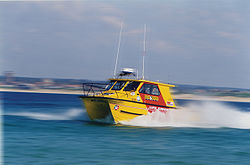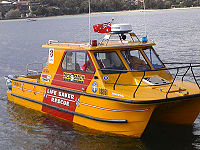
Cronulla District Lifesaver Rescue
Encyclopedia

Since its beginning, the service has saved over 1,200 lives.
The rescue boat

The boat has an operational time of 10 hours, powered by twin 200 horse power Yamaha engines with two 275 litre fuel tanks. The vessel can reach speeds of up to 100k/h. The rear deck of the boat has a clear operational area of about seven square metres, allowing easy access for boat and helicopter rescue crews. See Westpac Life Saver Rescue Helicopter Service
Westpac Life Saver Rescue Helicopter Service
The Westpac Life Saver Rescue Helicopter Service was founded in 1973 by Surf Life Saving Australia. Since this time, the Service has carried out more than 50,000 flights ranging from patient transfers to search and rescue missions...
.
Role
The Cronulla District LifeSaver Rescue Service works with the Water PoliceWater police
Water police, also called harbour patrols, port police, marine/maritime police, nautical patrols, bay constables or river police, are police officers, usually a department of a larger police organisation, who patrol in water craft...
, NSW Police, NSW Maritime
NSW Maritime
NSW Maritime was an agency in the Government of New South Wales, Australia. NSW Maritime was the State Government Authority responsible for marine safety, regulation of commercial and recreational boating and oversight of port operations...
, Coast Guard
Coast guard
A coast guard or coastguard is a national organization responsible for various services at sea. However the term implies widely different responsibilities in different countries, from being a heavily armed military force with customs and security duties to being a volunteer organization tasked with...
, PolAir Helicopters, Westpac Life Saver Rescue Helicopters, Bate Bay Surf Life Saving Clubs as well as clubs in the Royal National Park, and CareFlight
CareFlight International Air Ambulance
CareFlight International Air Ambulance is an Australian registered charity that operates air ambulances and specialist medical teams to patients anywhere in the world. The organisation was incorporated in 1986 when its first helicopter, a Squirrel AS350B was commissioned...
helicopters in providing rescue and emergency medical care to the people on Sydney's waterways.
Skipper
A skipper is responsible for communicating with the emergency services and relative authorities. They co-ordinate all rescue operations involving the rescue vessel and its crew. A skipper holds a Bronze Medallion, VHF Radio Operators Certificate, Advanced Resuscitation Certificate, and Senior First Aid Certificate. They are also qualified to drive the rescue vessel and 4WD, as well as act as crew when required.Driver
Is responsible for driving the rescue vessel, and are trained to operate the vessel in emergency situations. They are also proficient to act as Rescue Crew if required.Rescue crewperson

Defibrillation
Defibrillation is a common treatment for life-threatening cardiac arrhythmias, ventricular fibrillation and pulseless ventricular tachycardia. Defibrillation consists of delivering a therapeutic dose of electrical energy to the affected heart with a device called a defibrillator...
, basic medical care; and hold a Bronze Medallion, Advanced Resuscitation certificate, and Senior First Aid Certificate. Additionally Rescue Crew can hold Life Support qualifications, and Defibrillator Operator certificates.

